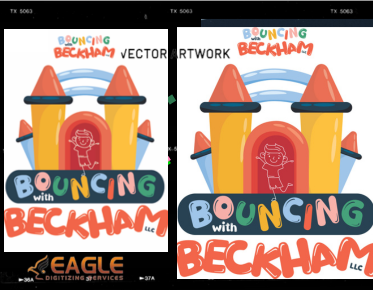Myth: You Can’t Use Vectors on Websites
The internet is filled with opinions, but one myth that continues to pervade the world of web design is that vectors don’t belong on websites. Some believe vectors are too complex, too slow, or just not practical for digital spaces. This misconception couldn’t be further from the truth. Vectorshave become an indispensable part of modern web design, offering unparalleled flexibility and performance. With advances in technology and the rise of responsive design, vectors are now essential for creating websites that are both visually striking and highly functional. It’s time to unravel the mystery surrounding them and understand why they’re the ideal choice for building sleek, fast, and adaptable websites.
Understanding
the Common Misconception
For
some, the idea of vectors in web design evokes
images of heavy, complicated graphics that might be cumbersome to implement or
load. This misconception arises from a basic misunderstanding of what vector
art is and how it functions. Unlike raster graphics, which are pixel-based and
can become blurry when resized, vector graphics are defined by mathematical
formulas that ensure their clarity and precision. But for many, the technical
aspect of vectors remains elusive, leading them to believe these designs are
not well-suited for websites. In reality, vectors simplify design processes by
providing clarity and efficiency in both simple and intricate graphics,
allowing web developers to enhance user experience without sacrificing quality
or speed.
Why
Some Think Vectors Are Not Web-Friendly
The
root of the myth lies in the assumption that vectors can’t deliver the visual
quality or versatility needed for dynamic, interactive websites. Some argue
that vectors are more suited for print or static uses. However, this simply
isn’t the case. With advancements in technology and web design tools, vectors
are just as viable, if not more so, for web-based applications. As web
standards evolve, so do the capabilities of vector graphics, which now include
complex animations and interactive elements. Still, the myth endures due to
outdated ideas about file formats and design limitations. It’s crucial for
designers to understand how to leverage modern vector formats and incorporate
them into dynamic web designs to unlock their full potential.
A Quick Dive Into Vector Art
Vector
art is a digital representation of paths and points, often used for illustrations,
logos, icons, and other graphic elements. The beauty of vector art lies in its
precision and scalability. Whether you’re designing a tiny website icon or a
large-scale billboard, vector graphics maintain their sharpness and clarity.
Unlike raster images, which lose quality when resized, vector graphics can be
infinitely scaled without any loss in detail. This makes them ideal for both
small web elements and large-format designs. Additionally, vectors provide
flexibility in customization, allowing designers to quickly modify their
artwork to fit a variety of web formats and styles.
The Basics of Vector Files: SVG, EPS, AI, and More
Common
vector file types include SVG (Scalable Vector Graphics), EPS (Encapsulated
PostScript), and AI (Adobe Illustrator). Of these, SVG is the most web-friendly
due to its lightweight nature and seamless integration into HTML. SVG files are
also compatible with CSS and JavaScript, making them ideal for creating
interactive web elements and animations. EPS and AI files are commonly used in
design software and for print, but SVG has become the go-to for web usage due
to its efficiency and compatibility. This makes it easier for developers to
implement vector graphics directly into the
code, resulting in a smoother and faster user experience.
Why Vectors Are Perfect for Websites
Vectors are far more than just clean graphics—they are a powerful tool
for web design, offering scalability, adaptability, and precision. These traits
make them perfect for the ever-evolving demands of web-based content. In
addition to their visual benefits, vectors help improve overall site
performance by reducing file sizes and improving load times. As websites grow
increasingly complex and mobile-friendly, vectors are poised to play a
significant role in shaping the future of web design. With their ability to
seamlessly integrate into different screen sizes and platforms, vectors are
becoming a go-to choice for modern web aesthetics and functionality.
Scalability:
The Key to Perfect Web Design
The real magic of vectors lies in their ability to scale infinitely
without losing quality. This means no matter what size screen or resolution a
user is viewing your website on, your design will remain crisp and clear. The
ability to resize without distortion is a key advantage over raster-based
images, which can become pixelated or blurry when stretched or compressed. As
the variety of devices used to access the internet continues to grow,
scalability has become an essential feature for responsive design. Vectors are
particularly valuable for designers who want their graphics to remain visually
appealing on everything from desktop monitors to mobile phones.
Vector
Art and Resolution Independence
Another
compelling reason vectors excel on the web is their resolution independence.
Because vector art is based on mathematical calculations, it remains sharp at
any resolution—whether it’s a smartphone screen, tablet, or
ultra-high-definition display. This makes them the ideal choice for responsive
web design, where content must adapt to varying screen sizes and resolutions.
Vectors eliminate the need for multiple versions of the same graphic, saving
time and resources while ensuring a consistent user experience across devices.
This adaptability makes vector graphics a must-have tool for designers aiming
to create seamless, high-quality websites.
Web
Design on the Go: Vectors for Mobile-Friendly Sites
In
today’s digital landscape, mobile optimization is essential. Vectors are
perfectly suited for this, offering a sharp, responsive experience across
various screen sizes. With mobile-first design becoming the standard, web
developers are increasingly relying on vector-based graphics to ensure their
websites look great on smartphones and tablets. Unlike raster images, which can
become pixelated or distorted on smaller screens, vectors maintain their
quality regardless of the display size. This ensures a smooth, consistent
experience for users, no matter what device they’re using to access your site.
Responsive
Design: How Vectors Make Websites Shine on Any Screen
Responsive
design is all about ensuring a website adapts to different screen sizes and
orientations. Vectors play a vital role in this because they can be scaled up
or down without compromising visual quality. This is particularly important
when designing websites for mobile-first experiences, where flexibility and
user-friendly layouts are key. By using vectors inresponsive design, designers can ensure their graphics are displayed
perfectly on everything from small mobile screens to large desktop monitors,
providing a seamless and visually appealing user experience.
Mobile Optimization: Vectors for Small Screens Without Sacrificing Quality
On
smaller screens, every pixel counts. Using vector art ensures that your site’s
graphics remain sharp and legible, even on compact devices. Unlike raster
images, which can look blurry or pixelated on high-resolution mobile displays,
vector graphics retain their precision and clarity. This makes vectors an ideal
choice for mobile optimization, where maintaining high visual quality in a
small space is crucial. Whether it’s a logo, icon, or illustration, vectors
provide the flexibility needed to create designs that are both visually
stunning and functional on any device.
Loading Speed: The Fast Lane of Vector Art
A major concern for web developers is ensuring fast loading times. The
good news is that vectors are incredibly efficient when it comes to file size.
Because they are defined by mathematical equations rather than pixel-based
data, vector graphics tend to be much smaller in file size than high-resolution
raster images. This results in faster load times, which is critical for user
experience and SEO. Additionally, vectors can be easily compressed and
optimized without losing visual quality, making them an essential asset for
creating lightweight, fast-loading websites.
How
Vectors Keep Your Site Light and Snappy
Vectors
are lightweight compared to high-resolution raster images. Their mathematical
structure means they require less storage space, allowing your website to load
faster and perform better. By reducing the amount of data needed for graphics,
vectors help streamline web performance without compromising quality. This
makes them particularly useful for sites that rely on fast loading times to
maintain user engagement and reduce bounce rates. When optimized correctly,
vector graphics can provide an efficient and visually appealing solution for designers
looking to improve website speed.
The
Myth of Slow-Loading Vectors: Debunking the Speed Argument
One
of the myths surrounding vectors is that they can slow down a website’s loading
speed. In reality, vector graphics are typically smaller in file size than
their raster counterparts. As long as vectors are
optimized correctly, they load quickly and efficiently, making them a perfect
choice for fast-loading websites. This is especially important in today’s
digital world, where users expect websites to load instantly. By using vectors
instead of raster images, web designers can achieve a balance between
high-quality visuals and fast performance.
High-Quality
Graphics with Low File Size
The combination of high-quality output and small file size is what
makes vectors stand out in the world of web design. This allows designers to
create visually stunning websites without sacrificing speed or performance.
Vectors offer unparalleled clarity and detail, even in complex designs, while
keeping file sizes to a minimum. This is especially important for websites that
rely on multiple graphic elements, such as icons, logos, and illustrations. By
using vectors, web developers can ensure that their sites remain fast and
efficient without compromising on visual quality.
How
Vectors Are File-Size Friendly
Unlike
raster images that require more storage space to maintain high quality, vector
graphics are resolution-independent, meaning they maintain their sharpness
without bloating file size. For web designers focused on site performance, this
is a game-changer. By using vectors, you can reduce the overall file size of
your website without sacrificing image quality. This leads to faster load times
and better user experience, which ultimately improves your site’s SEO and
engagement metrics.
Quality
Without the Bloat: Why Vectors Win Over Raster
Raster
images, especially high-quality ones, can become quite large, resulting in
slower website performance. Vectors offer a solution, delivering crisp and
beautiful graphics without the weight. This makes them perfect for designs that
require multiple assets at various sizes. Whether it’s a logo, icon, or
background image, vectors provide the flexibility to create designs that look
sharp and clear at any size, while keeping file sizes small and manageable.
Faster loading times and a more seamless user experience are the outcomes of
this.
Vectors
vs. Raster: The Battle for the Web
When choosing between vector and raster graphics, there are key differences that make vectors the superior choice for most web applications. Raster images are made up of a fixed grid of pixels, which means they are resolution-dependent and can lose quality when resized. On the other hand, vector graphics are based on mathematical formulas, allowing them to scale infinitely without any loss of quality. This makes vectors the clear winner for designs that need to be flexible, responsive, and sharp on any device or screen size. Additionally, vector graphics require less storage space and load faster, which is essential for maintaining optimal web performance.
When to Choose Vector Over Raster for Your Site
While raster images are great for detailed photography and realistic imagery, vectors are far better suited for designs that require scalability and clarity, such as logos, icons, and illustrations. Vectors are perfect for designs that need to look great on any screen size, from a mobile phone to a large desktop monitor. They also excel in situations where you need graphics that can be easily resized or customized, such as for responsive design or mobile optimization. For elements like navigation icons, logos, and infographics, vectors offer unmatched versatility and crispness, making them the preferred choice for most web designs.



